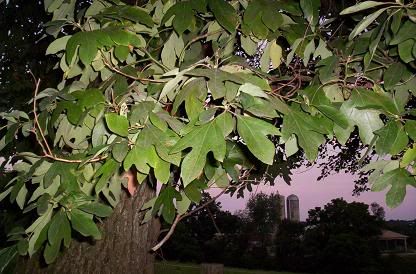Last evening's wanderings had us out along the edge of the evergreen farm, dodging spider webs and mosquitos in the gathering dusk. The sun went down like a cantaloupe into a dish of rosy syrup, and the night air was cool enough to walk without discomfort for the first time in weeks. I noticed at my feet a scarlet mitten shaped leaf, and stopped to look around and see where the tree was. Sassafras is usually small, scrubby bush-like growth - maybe 10-12 feet high, so it was a surprise to find that several trees of a good height were along the edge of the next field. The first tree we needed to stretch up to reach the lowest branches. The next had branches at eye-level.
The Sassafras albidum is a plant I remember fondly from childhood. It grew profusely in the woods around the house, and the mittens that grew amongst the 3 differently shaped leaves were a fascination. The scent of the twigs is that of root beer. If you look carefully at the photo above, you can make out the 3 different shapes... the single lobed leaves, the mittens, and the "two-thumbed mittens".
Sassafras leaves are used to make the spice Gumbo File. They are dried and then ground to a fine powder. When added to Gumbo (1 Tbsp. per quart) it thickens the liquid. It is added at the end of cooking, and not boiled.
The root bark of young saplings is used for tea. This is gathered when the tree is dormant, and dried until brittle. The bark can be used repeatedly to produce the delicious deep-rose colored tea. I remember people making root beer when I was little. Gathering sassafras roots (and others, most likely), they'd mix up their family recipe, put it in gallon jugs, and set it in the mild spring sun to "ripen". There was a slight fizziness, if I recall, formed by the formenting of the beverage. The tea can also be used as the liquid for a hard-crack candy or brittle, or a light syrup. It was used for ages as a spring tonic - to get the sap running in the spring. I must add here that a component - Safriole, I believe - has been found to be a carcinogen when shoveled into lab rats. Used as a spring tonic, or the occasional cup of tea, we would be hard pressed to ever consume quantities anything like the poor rats. At an herb conference it was once explained that: there are far more carcinogens in a can of beer than in a cup of tea, but A) there is no sassafras lobby in Washington, and B) nobody ever consumes a 6-pack of sassafras tea in an evening, but as usual we must all educate ourselves and make our own decisions about such matters.
Sassafras is one of those things that just makes me happy to see. Childhood associations of being in the woods with my grandfather combined with the appeal to my senses (visual, scent, touch) are very strong. It was also growing along the back of our shop at the renaissance faire, and seems to pop up to wave hello whenever I'm in a deciduous woodland.
Recently I read some threads on a list where folks were saying that they thought wildcrafting plants was very dangerous. It made me a little sad that they've become so distant from the plants around them. It is true that one cannot plunge into it and put every leaf, root, or berry into their mouth without knowing what it is, but to me, this is who we are... almost inherent knowledge that some are quick to throw away. To pay $3.99 for a pint of raspberries, after passing them growing wild (and free) on the way to the grocery store just makes no sense to me.
1 comment:
Lovely profile of this tree. Thank you for sharing your memories of it.
I've enjoyed sassafras as one of the few herbs I had real contact with as a child, although in a 'frosty mug'. As an adult I've added it to my chai mixes as a blood cleanser and burned it as an incense with juniper for the invigorating woodsy aroma.
Thank you for painting such nice pictures and invoking wonderful aromas with your words.
Post a Comment